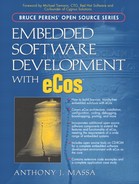Book Description
How to build low-cost, royalty-free embedded solutions with eCos
Covers eCos architecture, installation, configuration, coding, debugging, bootstrapping, porting, and more
Incorporates additional open source software components to extend the features and functionality of eCos, meeting the requirements of a wide range of embedded systems
Includes open source tools for a complete embedded software development environment with eCos as the core
Contains extensive code examples and complete application case study
Foreword by Michael Tiemann, CTO, Red Hat Software and Co-founder of Cygnus Solutions
"Anthony's book is easily the most complete treatment of eCos system development. I believe it is destined to become part of every eCos developer's library."
—Michael Tiemann, CTO, Red Hat Software and Co-founder of Cygnus Solutions
Build low-cost, royalty-free embedded solutions with eCos—step by step.
The Embedded Configurable Operating System (eCos) gives professionals a low-cost, royalty-free embedded software development solution that works in highly constrained hardware environments, while scaling smoothly to larger products. In this start-to-finish guide to eCos solution building, Anthony Massa covers eCos architecture, installation, configuration, coding, deployment, and the entire eCos open source development system. Additional open source tools are included to configure a complete embedded software development environment. Massa's code examples and application case study illuminate techniques for building virtually any embedded system, from the simplest device to complex Internet-enabled wireless systems. Coverage includes:
Understanding eCos architecture: kernel, hardware abstraction layer, and other components
Preparing your eCos embedded development environment
Incorporating additional open source tools for a complete embedded software development environment
Working with exceptions, interrupts, and virtual vectors
Managing threads and synchronization
Utilizing the eCos networking stack, I/O system, and file system
Covering additional eCos functionality, including third-party open source contributions
Using RedBoot, the standardized embedded debug and bootstrap solution
Porting eCos to new hardware platforms
Table of Contents
- Copyright
- About Prentice Hall Professional Technical Reference
- Foreword
- Preface
- An Introduction to the eCos World
- The Hardware Abstraction Layer
- Exceptions and Interrupts
- Virtual Vectors
- The Kernel
- Threads and Synchronization Mechanisms
- Other eCos Architecture Components
- Additional Functionality and Third-Party Contributions
- The RedBoot ROM Monitor
- The Host Development Platform
- The eCos Toolset
- An Example Application Using eCos
- Porting eCos
- About the Author
- The GNU General Public License (GPL)Version 2, June 1991
- About the CD-ROM
- Supported Processors and Evaluation Platforms
- eCos License
- Cygwin Tools Upgrade Procedure
- Building the GNU Cross-Development Tools
- Index
